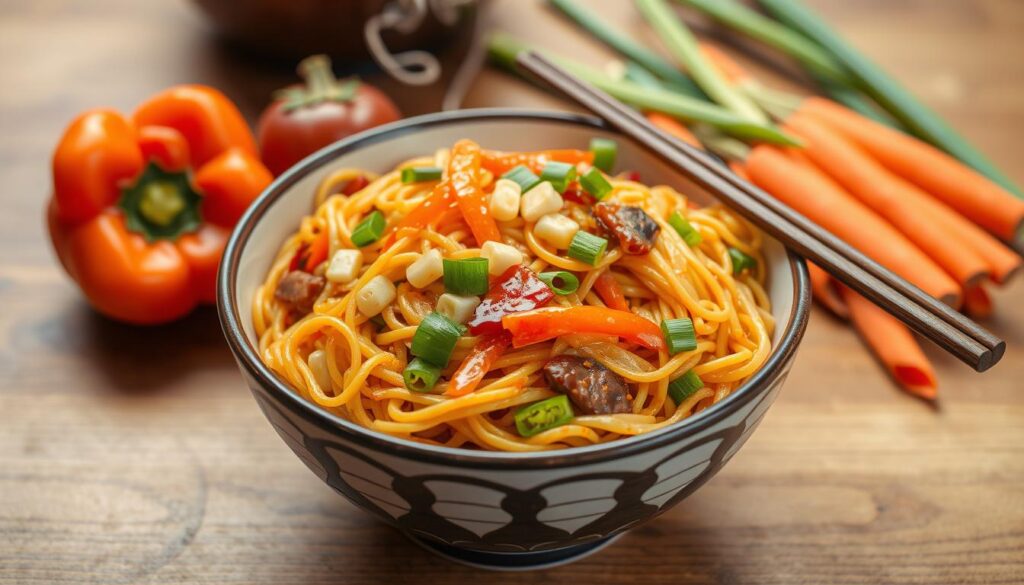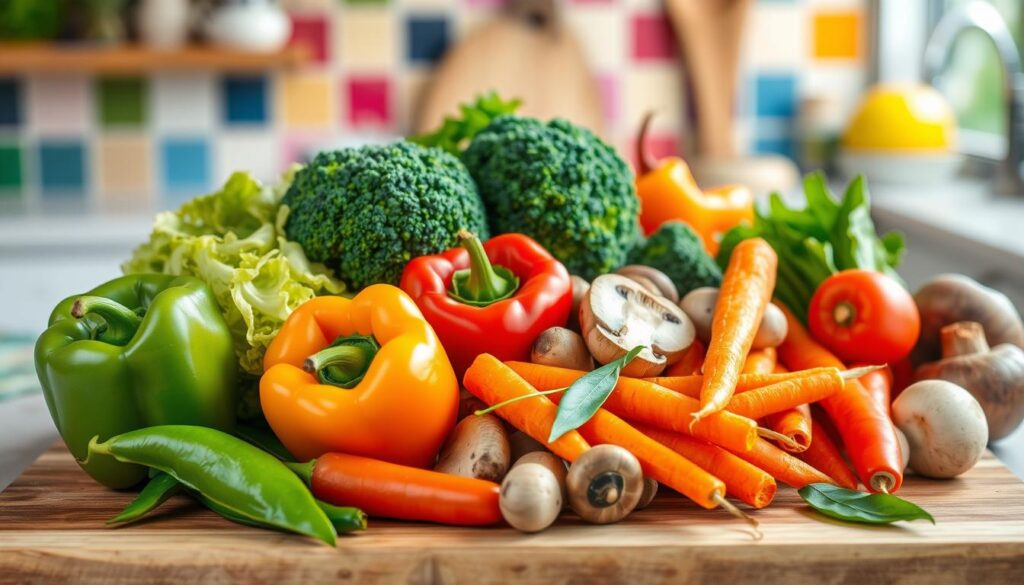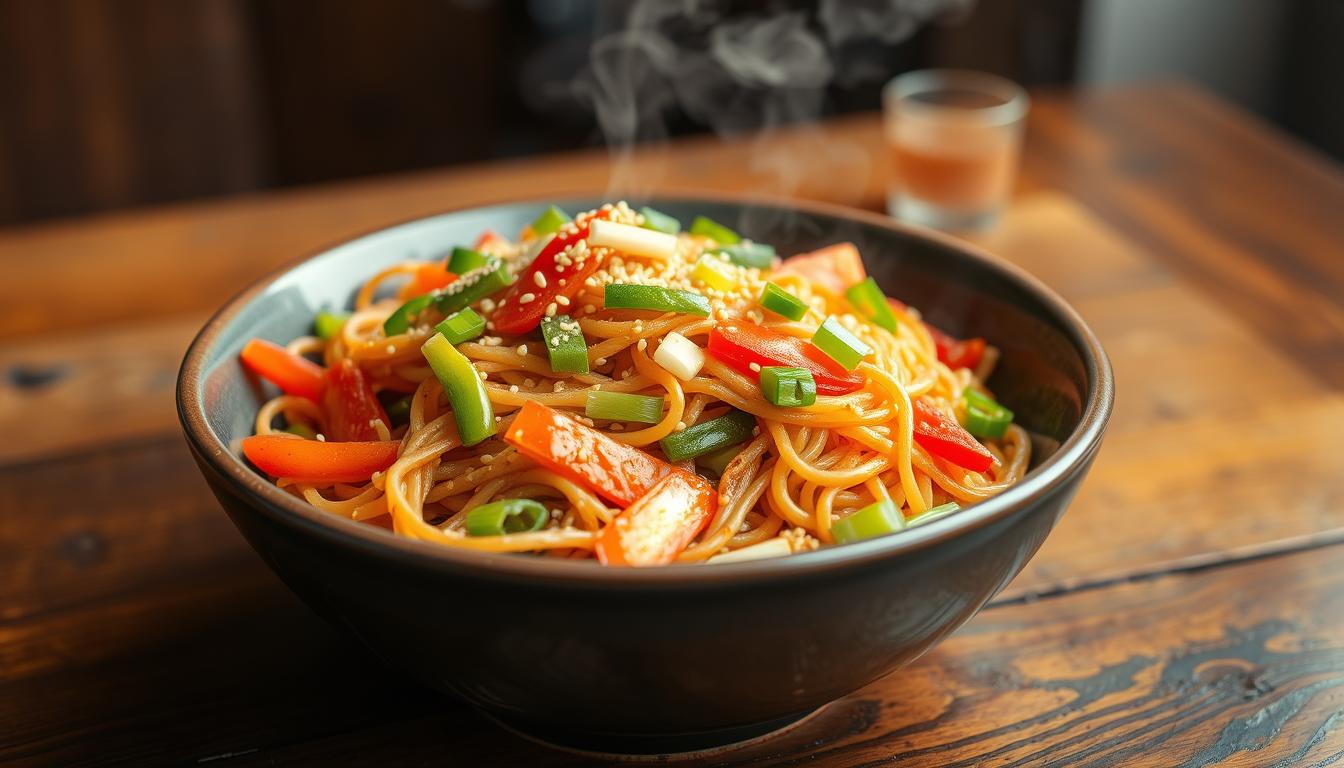Learn to make a tasty chow mein dish with ramen noodles in under 30 minutes. This simple recipe brings the flavors of Chinese cuisine right to your home. You’ll discover how to make a great sauce, stir-fry veggies perfectly, and get the right noodle texture for a real Asian meal.
Chow mein is a favorite Chinese noodle dish loved by many. Using ramen noodles makes it quick and easy to enjoy at home. It’s perfect for a comforting Asian meal or to spice up your dinner routine. This recipe with ramen noodles is sure to be a hit with your family.
Table of Contents
Understanding Chow Mein: Origins and Popular Variations
Chow mein is a favorite in Chinese cuisine with a long history. It started in China and has grown, mixing east asian flavors with local tastes worldwide.
Difference Between Chow Mein and Lo Mein
Chow mein and lo mein both have noodles, but they’re made differently. Chow mein noodles are stir-fried to be crispy. Lo mein noodles are tossed in sauce, making them soft and pliable.
Traditional vs Modern Interpretations
Old-school chow mein uses thin, crispy noodles. But today, you can find thicker, chewier noodles too. This dish has changed, now with rice noodles and even plant-based proteins.
Regional Cooking Styles
| Region | Chow Mein Characteristics |
|---|---|
| Cantonese | Featuring a light, savory sauce and a mix of vegetables and proteins. |
| Sichuan | Often incorporating bold, spicy flavors and a variety of aromatic spices. |
| American-Chinese | Typically features a heavier, sweeter sauce and a generous amount of vegetables and proteins. |
These regional styles show how chinese cuisine has spread. Chow mein is now loved as a asian noodle dishes globally.
Essential Ingredients for Perfect Chow Mein
Making the best chow mein starts with picking the right ingredients. The base of any great chow mein is the noodles. You can choose from Ramen, yakisoba, or lo mein noodles. Each type changes the texture and flavor.
Then, think about the veggies. Cabbage, carrots, celery, and bean sprouts add a nice crunch. Don’t forget garlic and ginger for extra savory flavor.
| Ingredient | Quantity |
|---|---|
| Chow Mein Noodles | 12 oz |
| Chicken Breast | 1 lb |
| Cabbage | 3 cups, thinly sliced |
| Carrots | 2 cups, shredded |
| Celery | 2 stalks, thinly sliced |
| Scallions | 6, cut into 1-inch pieces |
| Garlic | 2 cloves, minced |
The chow mein sauce is crucial. Mix soy sauce, oyster sauce, and sesame oil for the real taste. Add cornstarch to thicken it just right.
With the right noodles, veggies, and sauce, you’re set for a tasty noodle stir-fry. Try different vegetable noodles and soy sauce recipes to make it your own!
Chow Mein Recipe Ramen Noodles: Step-by-Step Guide
Make your weeknights better with this tasty chow mein recipe using ramen noodles. This guide will show you how to prepare the noodles, make the sauce, and stir-fry like a pro. You’ll get a chow mein dish that’s as good as any restaurant’s, right in your kitchen.
Preparing the Noodles
First, boil a big pot of water. Then, add the ramen noodles and cook them a bit less than the package says. This keeps them from getting too soggy later. After cooking, drain the noodles and put them aside.
Creating the Signature Sauce
In a small bowl, mix together soy sauce, brown sugar, minced garlic, grated ginger, and oyster sauce. This sauce is key to a great chow mein. It adds a mix of savory, sweet, and umami flavors.
Stir-Frying Technique
Heat a big wok or skillet on high and add some oil. Stir-fry sliced cabbage, carrots, bell peppers, and scallions until they’re just tender. Then, add the noodles and sauce, tossing everything for 2-3 minutes. This quick cooking keeps the veggies crisp and the noodles slightly crispy.
Right away, serve your chow mein recipe with ramen noodles. Add more scallions or sesame seeds if you like. This quick meal brings the flavors of wok cooking right to your table.

Best Noodle Options and Substitutions
Traditional chow mein uses thin egg noodles. But, you can also use ramen noodles for a tasty twist. Yakisoba or lo mein noodles add a chewy texture to your dish.
Rice noodles are great for those who need gluten-free options. If you’re in a hurry, spaghetti noodles can also work well. Try different noodles to find your favorite taste and texture.
| Noodle Type | Characteristics | Substitution Suitability |
|---|---|---|
| Udon Noodles | Thick, chewy wheat noodles | Excellent substitute for ramen noodle hacks |
| Soba Noodles | Thin, made from buckwheat flour | Healthy alternative to ramen noodles |
| Rice Noodles | Thin, translucent, made from rice flour | Versatile option for asian noodle dishes |
| Chinese Egg Noodles | Yellow, springy, made with wheat flour and eggs | Authentic flavor and texture for chow mein |
| Green Bean Noodles | Light, delicate, made from mung beans | Suitable low-carb alternative to ramen noodles |
Discover the wide world of asian noodle dishes and ramen noodle hacks. Try these different noodles to make a delicious chow mein dish.
Creating the Perfect Chow Mein Sauce
The secret to a great chow mein is the sauce. Getting the flavors just right is key to making this Asian dish shine. We’ll look at the base ingredients, flavor boosters, and how to get the sauce just right.
Base Ingredients
The sauce starts with soy sauce, oyster sauce, and sesame oil. These three create the savory, umami taste that chow mein is known for.
Flavor Enhancers
To deepen the sauce, add garlic, ginger, brown sugar, and rice vinegar. These ingredients balance the soy sauce’s saltiness. They also add sweetness and a tangy touch.
For a spicy kick, try chili sauce or red pepper flakes. They add heat to your soy sauce recipes and east Asian flavors.
Sauce Consistency Tips
- Use cornstarch to thicken the sauce. Start with a little and add more until it’s just right.
- Keep tasting the sauce and adjust the sweetness and salt. Start with a small amount and add more as needed.
- Adding chicken or vegetable broth can enhance the flavor. It also helps the sauce stick to noodles and veggies better.
Mastering the chow mein sauce is the first step to a delicious Asian meal at home. With practice, you’ll get it just right.
Vegetable and Protein Combinations
Creating the perfect vegetable noodle stir-fry is all about endless possibilities. Start with cabbage, carrots, and bean sprouts for a solid base. Then, add more veggies like bok choy, bell peppers, mushrooms, or snap peas for extra nutrition and taste.
For protein, you have many choices. Chicken, beef, and shrimp are favorites, but tofu is great for vegetarians. Extra-firm tofu or scrambled eggs can add a nice texture. The goal is to mix veggies and proteins for a tasty and satisfying chow mein.
The great thing about vegetable noodle stir-fry dishes like chow mein is their flexibility. Try different combinations to find your favorite flavors and textures. A little creativity can turn simple chow mein into a memorable meal.

For a quick 30-minute vegetarian chow mein, veggies make up 60% of the dish. Tofu, the protein, is 11%. Noodles are 29%. The sauce is a mix of soy and oyster sauce, with options to adjust to your liking. You can customize your chow mein with various veggies, making it a healthy and enjoyable meal every time.
Tips for Achieving Restaurant-Style Results
Want to make your homemade chow mein taste like it’s from a restaurant? Follow these expert tips. The secret to authentic Chinese food is in the technique. With a few tweaks, you can get that wok hei (wok breath) flavor at home.
Wok Cooking Techniques
Get a well-seasoned wok or large skillet for top results. A wok’s high heat is key for searing and caramelizing, keeping flavors in. Make sure your wok or pan is super hot before adding oil and ingredients. Also, have all your ingredients ready to go, as stir-frying is fast.
Temperature Control
- Keep the heat high throughout cooking. If the temperature drops, your noodles might end up soggy instead of wok-charred.
- Watch the oil temperature to avoid burning. Burnt oil tastes bitter and acrid.
- Stir the ingredients often to cook evenly and prevent sticking. Quick movements and high heat are what create that wok hei flavor.
With these wok cooking tips and temperature control, you’ll make restaurant-quality chow mein in no time. The trick is in the prep and how you cook it.
Common Cooking Mistakes to Avoid
Making a perfect noodle stir-fry or quick Asian dish is fun. But, avoid common mistakes to keep your meals tasty. Overcooked noodles and uneven veg cooking are big no-nos. Here’s how to avoid these for quick meals that taste great.
- Don’t overcook the noodles: Perfectly al dente noodles are key for a great noodle stir-fry. Mushy noodles ruin the dish. Cook noodles for about 2 minutes, then rinse in cold water to stop cooking.
- Avoid overcrowding the pan: Don’t put too many ingredients in the pan. This can make it steam instead of fry. Cook in batches to keep the right temperature.
- Use the right amount of oil: Just the right oil prevents sticking and gets a nice sear. Too little oil makes it dry, too much greasy.
- Time the sauce addition carefully: Add sauce at the end to avoid soggy noodles. Toss with sauce when cooking is done.
- Cut vegetables uniformly: Make sure all veg pieces are the same size for even cooking. This prevents some from getting overcooked.
- Taste and adjust seasoning: Before serving, taste and adjust the seasoning. This ensures your noodle stir-fry or quick meal is perfect.
Remember these tips to make noodle stir-fry and quick meals that look and taste great. Enjoy your tasty creations!
| Ingredient | Quantity |
|---|---|
| Chow mein noodles | 200g |
| Onion, thinly sliced | ½ |
| Celery, thinly sliced | 1 stalk |
| Cabbage, roughly chopped | 1 leaf |
| Soy sauce | 3 tbsp |
| Sugar | 1 tbsp |
| Shaoxing wine | 1 tbsp |
| White pepper | Pinch |
| Sesame oil | 1 tsp |
| YumYum (or MSG) | ½ tsp |
| Chicken stock | ½ cup |
Conclusion
Making chow mein at home with ramen is quick, customizable, and affordable. You can make it just like your favorite restaurant. Try different veggies, proteins, and sauces to keep it exciting.
The chow mein recipe ramen noodles lets you try many flavors and textures. You can go for crispy noodles or a tasty sauce. It’s all about finding the right mix of ingredients and cooking methods for a great quick asian dinner.
Knowing the difference between chow mein and lo mein helps you make your own versions. Stir-fry with different veggies and proteins. Experiment with sauces to find your family’s favorite chow mein recipe ramen noodles. Soon, you’ll be making delicious chow mein at home, satisfying your cravings for a tasty quick asian dinner.

